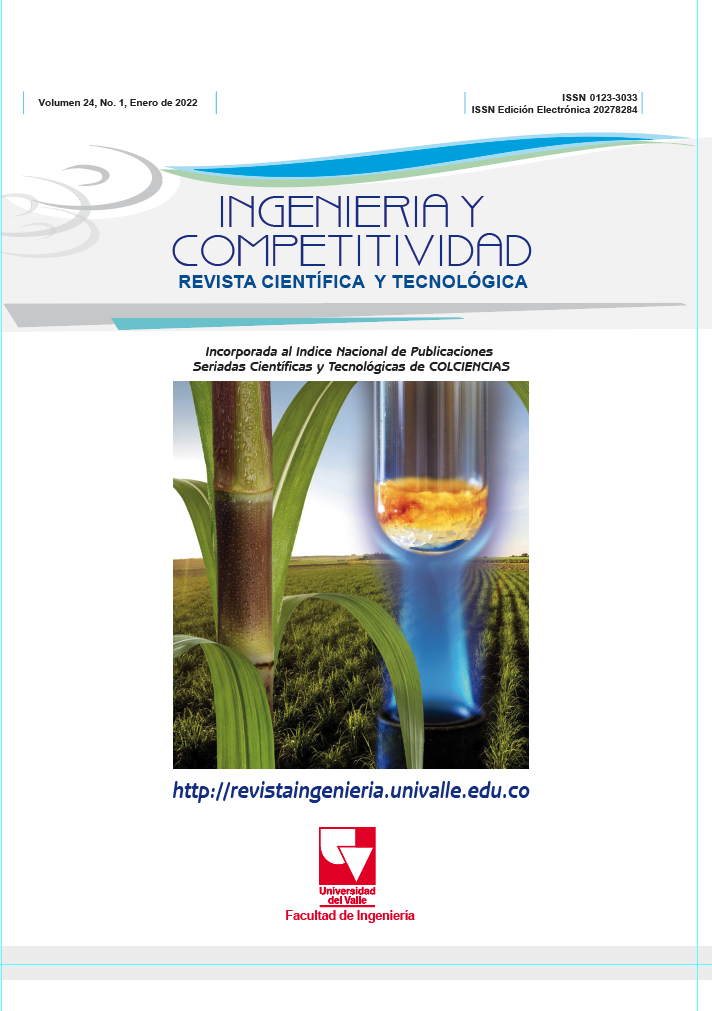Estudio del efecto de la intensidad de radiación y la concentración de H2O2 en el tratamiento de efluentes de la industria textil con UV/H2O2
Contenido principal del artículo
Diariamente se vierte una gran cantidad de aguas residuales textiles que contienen diversas sustancias químicas tóxicas, lo que representa un riesgo para los ecosistemas y la salud humana. Dado que los procesos de las plantas de tratamiento de aguas residuales municipales convencionales no eliminan eficazmente estos compuestos, en este estudio se evaluó el tratamiento real de las aguas residuales textiles mediante un tratamiento terciario con el proceso de oxidación avanzado, basado en UV/H2O2. Se aplicó un pretratamiento consistente en filtración y neutralización, seguido de un tratamiento UV/H2O2 variando la concentración de H2O2, también se varió la intensidad de la radiación utilizando un conjunto de lámparas de potencia de 15 W cada una. La mejor condición de degradación se obtuvo con una concentración de H2O2 de 0.10 M y una intensidad de radiación de 45 W, considerando una evaluación del consumo energético del tratamiento.
- aguas residuales textiles
- análisis de consumo energético
- potencia radiactiva
- procesos avanzados de oxidación
(1) El-Gohary F, Ibrahim, N, Nasr F, Abo-Shosha H, Ali H. A new approach to accomplish wastewater regulation in textile sector: an Egyptian case study. Cellulose Chemistry and Technology. 2013;47(3–4):309–315. Available from: https://www.cellulosechemtechnol.ro/pdf/CCT3-4(2013)/p.309-315.pdf
(2) Samsami S, Mohamadi M, Sarrafzadeh MH, Rene ER, Firoozbahr M. Recent advances in the treatment of dye-containing wastewater from textile industries: Overview and perspectives. Process Safety and Environmental Protection. 2020;143:138-63. https://doi.org/10.1016/j.psep.2020.05.034
(3) Green peace. Puntadas Tóxicas, el Oscuro Secreto de la Moda [Internet]. Green Peace; 2012. Available from: http://hdr.undp.org/en/media/HDR05_complete.pdf
(4) Flores A, Vitale P, Eyler G, Cañizo A. Remoción de colorantes textiles aplicando procesos fotoquímicos oxidativos (UV/H2O2 /lana de acero comercial). Afinidad. 2015;72(571):188–195. Available from: https://raco.cat/index.php/afinidad/article/view/300847.
(5) Botelho D, Cleto E, Rodriguez T. Treatment of industrial effluents of recalcitrant nature using ozone, hydrogen peroxide and ultraviolet radiation. Revista Facultad de Ingeniería. 2008;(46):24–38. Available from: https://revistas.udea.edu.co/index.php/ingenieria/article/view/17926.
(6) Khurana P, Thatai S, Sapna, Kumar D. Chapter 6 - Destruction of recalcitrant nanomaterials contaminants in industrial wastewater. In: Kumar-Mishra A, Anawar HMD, Drouiche N, editors. Emerging and Nanomaterial Contaminants in Wastewater Advanced Treatment Technologies. 2019;137–58. Available from: https://doi.org/10.1016/B978-0-12-814673-6.00006-1.
(7) Álvarez M, Ruidíaz-Martínez M, Cruz-Quesada G, López-Ramón M, Rivera-Utrilla J, Sánchez-Polo M, Mota A. Removal of parabens from water by UV-driven advanced oxidation processes. Chemical Engineering Journal. 2020;379:122334. https://doi.org/10.1016/j.cej.2019.122334
(8) Yagüe C. Eliminación de color en aguas de industrias de acabado de piel mediante tecnologías de oxidación [Doctoral Thesis]. Alicante: Universidad de Alicante; 2001. Available from: http://www.cervantesvirtual.com/nd/ark:/59851/bmc1z446
(9) Rodríguez A, Letón P, Rosal R, Dorado M, Villar S, Sanz J. Tratamientos Avanzados de Aguas Residuales Industriales. Madrid: CITME; 2006. Available from: http://www.madrid.org/bvirtual/BVCM001696.pdf
(10) Ebrahimi I, Parvinzadeh Gashti M, Sarafpour M. Photocatalytic discoloration of denim using advanced oxidation process with H2O2/UV. Journal of Photochemistry and Photobiology A: Chemistry. 2018;360:278-88. https://doi.org/10.1016/j.jphotochem.2018.04.053
(11) Edwards J. Investigación de la remoción de color por medio de oxidación química. Virtualpro [Internet]. 2007;(63):22-39. Available from: https://www.virtualpro.co/revista/industria-textil/22#4585
(12) Ministerio de Ambiente y Desarrollo Sostenible. Resolución 0631 de 2015. Parámetros y valores límites máximos permisibles en los vertimientos puntuales a cuerpos de agua superficiales y a los sitemas de alcantarillado público. 2015.
(13) Pire-Sierra M, Rodríguez-Sargent K, Fuenmayor-Reyes M, Fuenmayor Y, Acevedo H, et. al. Biodegradabilidad de las diferentes fracciones de agua residual producidas en una tenería. Ciencia e Ingeniería Neogranadina. 2011;21(2):5-19. https://doi.org/10.18359/rcin.257
(14) Fryda M, Matthée T, Mulcahy S, Höfer M, Schäfer L, Tröster I. Applications of DIACHEM® electrodes in electrolytic water treatment. Electrochemical Society Interface. 2003;12(1):40–44. https://doi.org/10.1149/2.F10031IF
(15) Theurich J, Lindner M, Bahnemann D. Photocatalytic Degradation of 4-Chlorophenol in Aerated Aqueous Titanium Dioxide Suspensions: A Kinetic and Mechanistic Study. Langmuir. 1996;12(26):6368–6376. https://doi.org/10.1021/la960228t
(16) Herrmann JM. Photocatalysis fundamentals revisited to avoid several misconceptions, Applied Catalysis B: Environmental. 2010;99(3–4):461–468. https://doi.org/10.1016/j.apcatb.2010.05.012
Descargas

Esta obra está bajo una licencia internacional Creative Commons Atribución-NoComercial-CompartirIgual 4.0.
Los autores que publican en esta revista están de acuerdo con los siguientes términos:
Los autores ceden los derechos patrimoniales a la revista y a la Universidad del Valle sobre los manuscritos aceptados, pero podrán hacer los reusos que consideren pertinentes por motivos profesionales, educativos, académicos o científicos, de acuerdo con los términos de la licencia que otorga la revista a todos sus artículos.
Los artículos serán publicados bajo la licencia Creative Commons 4.0 BY-NC-SA (de atribución, no comercial, sin obras derivadas).





